Johann Heinrich von Bernstorff
Johann Heinrich Graf[notes 1] von Bernstorff (14 November 1862 – 6 October 1939) was a German politician and ambassador to the United States from 1908 to 1917.
Johann Heinrich von Bernstorff | |
|---|---|
 Bernstorff in 1908 | |
| German Ambassador to the United States | |
| In office 1908–1917 | |
| Preceded by | Hermann Freiherr Speck von Sternburg |
| Succeeded by | Suspended due to World War I |
| German Ambassador to the Ottoman Empire | |
| In office 1917–1918 | |
| Reichstag | |
| In office 1921–1928 | |
| Personal details | |
| Born | 14 November 1862 London, United Kingdom |
| Died | 6 October 1939 (aged 76) Geneva, Switzerland |
| Political party | German Democratic Party |
| Spouse(s) | Jeanne Luckemeyer
(m. 1887; |
| Children | Luise-Alexandra (1888–1971) Christian-Günther (1891–1947) |
| Parents | Count Albrecht von Bernstorff Anna von Könneritz |
Early life
Born in 1862 in London, he was the son of one of the most powerful politicians in the Prussian Kingdom. As Foreign Minister for Prussia, his father, Count Albrecht von Bernstorff, had earned the ire of Otto von Bismarck in the Prussian constitutional crisis of 1859–1866. Overestimating his political strength, von Bernstorff resigned in a spat over the constitution with the expectation to force his will on the Prussian government. However, the Emperor accepted Bernstorff's miscalculated challenge and appointed von Bismarck chancellor and foreign minister. For the rest of his life, Count Albrecht von Bernstorff would criticise Bismarck's Machiavellian style of governing. In 1862, the elder Bernstorff served as ambassador to the Court of St James's. For the next eleven years young Bernstorff grew up in England until his father's death in 1873. After moving back to Germany Johann von Bernstorff went to the humanistic gymnasium in Dresden from which he graduated with a baccalaureate in 1881.
While von Bernstorff's dream had always been to pursue a diplomatic career, the family feud with Bismarck made an appointment to the diplomatic service impossible.[1] As a result, he joined the Prussian Army for the next eight years, serving in an artillery unit in Berlin.
After being elected a member of the Reichstag, he finally succeeded in convincing the Bismarcks to settle the dispute with the long dead father.[2] In 1887, von Bernstorff married Jeanne Luckemeyer, a German-American.[3] She was a native of New York City and daughter of a wealthy silk merchant.[4]
Career
First diplomatic postings
His first diplomatic assignment was Constantinople, where he served as military attaché. From 1892 to 1894, he served at the German embassy in Belgrade. After a brief assignment to St. Petersburg (1895–1897), von Bernstorff was stationed in Munich for a period. He then became First Secretary of the German embassy in London (1902–1906).[5] Bernstorff's diplomatic skills were noted in Berlin throughout the First Moroccan Crisis in 1905. He then served as consul general in Cairo (1906–1908).[6]
Despite his family's problems with the Bismarcks, von Bernstorff basically agreed with Bismarck's policies, particularly the decision to found the German Reich without Austria in 1871. As a diplomat, von Bernstorff adamantly supported Anglo-German rapprochement and considered the policies of Wilhelm II "reckless."[7]
Ambassador to the United States

In 1908, von Bernstorff was appointed the German ambassador to the United States.[9]
He was recalled to Germany on 7 July 1914 but returned on 2 August upon the outbreak of the First World War. It was later revealed that he had been recruited into intelligence work and ordered to assist the German war effort by all means necessary. He was also provided with a large slush fund to finance those operations. He began with attempts to assist German-Americans who wished to return home to fight by forging passports to get them through the Allied blockade.
Publicly, Bernstorff's ambassadorship in Washington was characterised by a diplomatic battle with the British ambassador, Sir Cecil Spring Rice, with both men attempting to influence the American government's position regarding the war.[10] Later, however, as the blockade began to prevent American munitions manufacturers from trading with Germany, the ambassador began financing sabotage missions to obstruct arms shipments to Germany's enemies. Some of the plans included destroying the Welland Canal, which circumvents Niagara Falls. That was attempted in September 1914 but failed. They year, the German diplomatic mission also began supporting the expatriate Indian movement for independence.
Bernstorff was assisted by Captain Franz von Papen, later a German chancellor, and Captain Karl Boy-Ed, a naval attaché. The commercial attaché, Heinrich Albert, was the finance officer for the sabotage operations. Papen and the German consulate in San Francisco are known to have been extensively involved in the Hindu–German Conspiracy, especially in the Annie Larsen gun running plot. Although Bernstorff himself officially denied all knowledge, most accounts agree that he was intricately involved as part of the German intelligence and sabotage offensive in America against Britain. After the capture of the Annie Larsen and confiscation of its cargo, Bernstorff made efforts to recover the $200,000 worth of arms, insisting they were meant for Colonel Paul von Lettow-Vorbeck in German East Africa. That was futile, however, and the arms were auctioned off.
In December 1914, Bernstorff received a cable from the German Foreign Office that instructed him to target the Canadian railways. On 1 January 1915, the Roebling Wire and Cable plant in Trenton, New Jersey, was blown up. On 28 January, an American merchant ship carrying wheat to Britain was sunk. On 2 February 1915, Lt. Werner Horn was captured following the Vanceboro international bridge bombing. In 1916 his wife was involved in blackmail plot by a former German spy, Armgaard Karl Graves.
In 1915, Bernstorff also helped organise what became known as the Great Phenol Plot, an attempt to divert phenol from the production of high explosives in the United States (which would end up being sold to the British), and at the same time prop up several German-owned chemical companies that made aspirin and its precursor, salicylic acid. In September 1915, his agents attempted to influence the negotiations between American banks and the Anglo-French Financial Commission, but failed to prevent an agreement being reached.
In July 1916, the Black Tom explosion was the most spectacular of the sabotage operations.
Some of Bernstorff's other activities were exposed by the British Secret Service when they obtained and distributed to the press a photograph of him "in a swimming costume with his arms around two similarly dressed women, neither of whom was his wife".[11]
Bernstorff was returned home on 3 February 1917, when Woodrow Wilson severed diplomatic relations with Germany after the resumption of unrestricted submarine warfare. Upon receiving the news, Colonel Edward M. House wrote to him, "The day will come when people in Germany will see how much you have done for your country in America."
In 1910, Brown University had conferred an honorary Doctor of Laws degree on Bernstorff. At the school's commencement in 1918 (while World War I was going on), university president William Faunce read a resolution of the board of fellows revoking the degree, because "while he was Ambassador of the Imperial German Government to the United States and while the nations were still at peace, [Bernstorff] was guilty of conduct dishonorable alike in a gentleman and a diplomat."[12]
Ambassador to the Ottoman Empire
He assumed his position as ambassador to the Ottoman Empire in 1917. Bernstorff conceded that the Ottoman policy against the Armenians was one of exterminating the race.[13] Bernstorff provided a detailed account of the massacres in his memoirs entitled, Memoirs of Count Bernstorff. In his memoirs, Bernstorff recounts a conversation that he had with Talat Pasha after the massacres were concluded: "When I kept on pestering him about the Armenian question, he once said with a smile: 'What on earth do you want? The question is settled, there are no more Armenians.'"[13]
Weimar Republic

Bernstorff was proposed as Foreign Minister in Philipp Scheidemann's cabinet in 1919, but he refused this post and left the diplomatic service.[9] He became a founding member of the German Democratic Party (Deutsche Demokratische Partei) and a member of the German Parliament in 1921–28. He was the first President of the German Association for the League of Nations, President of the World Federation of Associations of the League of Nations[6] and a member of every German delegation to the League of Nations.[14]
In 1926, he became the Chairman of Kurt Blumenfeld's Zionist German Pro-Palestine Committee (Deutsches Pro-Palästina Komitee) to support the foundation of a Jewish State in Palestine.[15] From 1926 to 1931 he was the chairman of the German delegation to the Preparatory World Disarmament Conference.[6]
Bernstorff, who was explicitly mentioned by Hitler as one of those men bearing "the guilt and responsibility for the collapse of Germany",[16] left Germany in 1933 after the Nazis rose to power and moved to Geneva, Switzerland, where he died on 6 October 1939.
Publications
- My three years in America (New York: Scribner's, 1920)[17]
- Memoirs of Count Bernstorff (New York: Random House, 1936)
Notes
References
- Heribert von Feilitzsch, In Plain Sight: Felix A. Sommerfeld, Spymaster in Mexico, 1908 to 1914, Henselstone Verlag, Virginia, 2012, pp. 203–204
- Tucker, Spencer (2006). World War I. Priscilla Mary Roberts. ISBN 9781851098798. Retrieved 19 October 2009.
- NY Times 8 November 1908
- "Bernstorff's wife again U.S. citizen," The New York Times, 25 February 1939, p. 13.
- "Latest intelligence - German diplomatic changes". The Times (36915). London. 3 November 1902. p. 4.
- Adam, Thomas; Kaufman, Will (2005). Germany and the Americas: culture, politics, and history. Thomas Adam. ISBN 9781851096282. Retrieved 19 October 2009.
- Johann Count von Bernstorff, Memoirs of Count Bernstorff, Random House, New York, NY, 1936.
- Donovan, Henry. "Chicago Eagle". Illinois Digital Newspaper Collections. Retrieved 26 June 2015.
- Venzon, Anne Cipriano; Miles, Paul L. (1999). The United States in the First World War: an encyclopedia. Anne Cipriano Venzon, Paul L. Miles. ISBN 9780815333531. Retrieved 19 October 2009.
- S. Gwynn, 'The Letters and Friendships of Sir Cecil Spring Rice' (Constable & Co Lt, London, 1929), 352.
- MI6, The History of the Secret Intelligence Service 1909 – 1949, Keith Jeffery, Bloomsbury, 2010. p. 113
- Martha Mitchell, "Honorary degrees" in Encyclopedia Brunoniana (1993).
- A., Bernstorff (2011). Memoirs of Count Bernstorff. Kessinger Publishing. ISBN 978-1-169-93525-9.
- Biography at Neue Deutsche Biographie
- Oscar Cohn, Ein Sozialist und Zionist im Kaiserreich und in der Weimarer Republik. Ludger Heid (in German). Campus. 2002. ISBN 9783593370408. Retrieved 19 October 2009.
- Weinberg, Gerhard L. (1996). Germany, Hitler, and World War II: essays in modern German and world history. Cambridge University Press. p. 38. Retrieved 21 October 2009.
- "Review of Deutschland und Amerika: Erinnerungen aus dem Fünfjährigen Kriege von Graf Johann Heinrich Bernstorff & My Three Years in America by Count Bernstorff". The American Historical Review. 26: 98101. 1920. doi:10.1086/ahr/26.1.98. ISSN 1937-5239.
External links
| Wikimedia Commons has media related to Johann Heinrich von Bernstorff. |
| Wikisource has the text of a 1922 Encyclopædia Britannica article about "Johann Heinrich von Bernstorff". |
- Bernstorff next to Chaim Weizmann and Albert Einstein in 1926 at the foundation of the pro-Palestine Committee
- Hoser, Paul: Bernstorff, Johann Heinrich, Graf von, in: 1914-1918-online. International Encyclopedia of the First World War.
- My Three Years in America by Johann Heinrich Bernstorff
- Count Bernstorff. My Three Years in America at Project Gutenberg